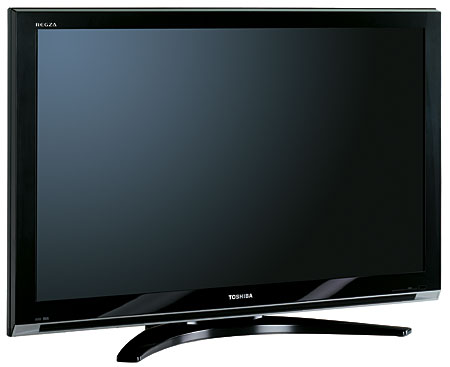Toshiba REGZA 52HL167 LCD 1080p Television

Toshiba's flat panels carry the odd designation REGZA, which, as Toshiba informs us, stands for Real Experience Guaranteed by Amazing Architecture (probably sounds better in Japanese). The 1920x1080p 52HL167 ($3,499) is the top model in Toshiba's standard series of flat panels. The Cinema Series sits above it. The main differences in the equivalent Cinema model, as far as I could determine, are a refresh rate of 120Hz, which is said to minimize motion blur, and a $500 higher price tag. Motion blur has, however, been a problem with some LCD designs, but it's now far less annoying than in the past, thanks to new technical refinements—and not just 120Hz operation.
Outside
At just under 102 lbs. (with stand), the 52HL167 is relatively heavy for a 52" flat panel. Pioneer's Elite PRO-FHD1 50" 1080p plasma weighs 88 lbs., though it does lack built-in tuners, audio amps, and speakers, and the Samsung LN-T5265F LCD is an anorexic 75 lbs. (review pending).
The set's sound comes out of a narrow slot at the bottom of its high gloss frame in a configuration Toshiba calls SoundStrip2. The controls and a single set of inputs- composite video with L/R analog audio- are located on the side at the bottom right.
The main inputs, around back, include three HDMI connections (version not specified) and two HD component connections (Toshiba refers to its Y-Pb-Pr component inputs as ColorStream). There is also a L/R analog input for the HDMI 1 video input to accommodate audio for a source with a DVI video output (DVI can connect to HDMI via a simple breakout cable for video, but cannot carry audio). There's also a fixed audio line-level L/R analog out, a digital Toslink optical audio output, and an RF antenna input for the set's onboard ATSC/NTSC tuner. Finally, the set has a service port for firmware updates.
Inside
As with all manufacturers today, Toshiba offers a wide range of features and technological whiz-bangs, from the vital to those that simply make hearts go all aflutter in the marketing department.
On the tech side, the big pull is, of course, 1080p. From its HDMI inputs, the Toshiba will accept all current standard definition and high-definition resolutions, including both 1080p/60 and 1080p/24.
Unfortunately, when the set receives a 1080p/24 input it adds 3/2 pulldown and then displays it at 1080p/60. This ostensibly negates any benefit from 1080p/24, apart from the ability of the set to accept such a source if no 1080 alternative is available. But I know of no sources currently in the market that don't offer 1080p/60 output.
Toshiba's image processing includes both ColorBurst, its designation for a claimed color gamut claimed to be 90% that of NTSC, and PixelPure 3G, the company's 3rd generation video processor. The latter uses 14-bit processing. While it's claimed that this offers 16 times the brightness gradations of 8-bit processing, remember that all current video sources are limited to 8-bits.
Processing at a higher bit depth can have benefits apart from making good ad copy, but the result is not equivalent to what we would see from higher bit depth from the original source. Deep Color can do this, but we see no sign if it being implemented in the consumer world. And just because a display has 14-bit internal processing does not mean that it could accept a 14-bit source—if one existed.
Toshiba's CineSpeed panel claims a response speed of 8ms and a viewing angle of 176 degrees. Until recently, both response speed and off-axis viewing are two areas of flat panel performance in which plasmas have held a distinct advantage over LCDs. As mentioned earlier, however, LCD manufacturers have recently begun to make significant improvements in both areas.
Toshiba's DynaLight Back Light control is said to provide dynamic adjustment of the backlight to produce a "dynamic contrast" up to 5x that of the original panel, with deeper black levels.
The other video controls include the usual gang of five: Contrast, Brightness, Color, Tint, and Sharpness. There's also a Back Light control to adjust the level of the cold cathode fluorescent (CCFL) backlight—an important feature for minimizing the overall image brightness when you don't need it, while improving the black level as well.
An Advanced Picture Settings menu includes Dynamic Contrast, Static Gamma, and Color Temperature. Dynamic Contrast worked surprisingly well. It deepened the black level and minimized the slightly washed-out appearance that was common in LCD sets until recently. It did, however, shift the black level slightly. I used its Middle setting at first, but soon gravitated to Low.
Static Gamma lightened or darkened the image in different ways from the other controls. Its action was centered in the mid-brightness region, with minimal effect on the darkest and brightest areas of the picture.
Each setting in the three-choice color temperature menu offers Blue and Green Drive controls. The sample I received measured best—quite good, actually—in the Warm setting. For more information about this, see "Tests and Calibration" at the end of the report.
The ColorMaster feature provides individual control over the hue, saturation, and brightness of the three primary and three secondary colors. ColorMaster actually was effective in moving the color points, which resulted in a subtle but noticeable improvement.
But it can only be used properly with precision test equipment, including a quality colorimeter, and the operation is tedious and time-consuming. If you don't have the tools and expertise, or can't hire a qualified professional calibrator who does, you're better off leaving the ColorMaster controls in their factory default positions. You can mess up the picture nicely by playing footsy with these adjustments, but your tinkering can be easily reversed by either choosing Reset or simply turning ColorMaster Off.
But this feature does have merit. It allows you to move the set's primary and secondary color points. This proved valuable here because the measured color points on this set (in particular, its oversaturated green) weren't particularly accurate out of the box.























































